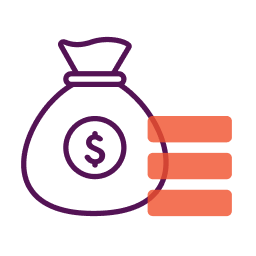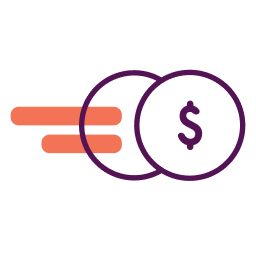On December 22, 2020 Congress passed the stimulus bill which provides for new for Paycheck Protection Program loans and other small business relief. Read more about that legislation and apply for a PPP loan here.
The President has signed the Paycheck Protection Program Flexibility Act of 2020. This law may make PPP loans more attractive to small businesses. Here are 7 of the main ways it may help your business:
1. More Money For Nonpayroll Expenses
Although not a provision of the CARES Act, guidance from Treasury and the SBA limits forgiveness for nonpayroll expenses to no more than 25% of the forgiven amount. At least 75% of PPP loan proceeds must go toward payroll and payroll-related costs to qualify for full forgiveness.
What changed: To qualify for forgiveness, the Paycheck Protection Program Flexibility Act allows up to 40% of PPP funds may be spent on certain nonpayroll expenses while at least 60% of the PPP loan proceeds must be spent on payroll and payroll-related expenses.
The types of nonpayroll expenses that may qualify for forgiveness don’t change. They are still limited to business rent, mortgage interest and utilities for services or obligations in effect by February 15, 2020.
NOTE: You can read more about PPP loan forgiveness HERE.
2. Triple The Time To Use Your Loan
Previously the “covered period” was the eight weeks after the loan is disbursed and ends June 30, 2020. Based on guidance from the SBA and Treasury, business owners who want to qualify for forgiveness must spend their PPP funds during the eight weeks after the loan is disbursed or the “alternative covered period,” which is the eight-week period that begins on the first day of their first pay period following their PPP loan disbursement date.
What changed: The covered period is “the period beginning on the date of the origination of a covered loan and ending the earlier of the date that is 24 weeks after such date of origination; or December 31, 2020.” This essentially triples the time during which the business owner can spend PPP funds and apply for forgiveness from eight to 24 weeks. (Note that business owners who received a loan before June 5, 2020 can still elect to stick with the 8 week period for forgiveness purposes.)
3. Business Owners Can Get PPP and Payroll Tax Deferral
The CARES Act allows employers to defer the deposit and payment of the employer’s share of Social Security taxes and self-employed individuals to defer payment of certain self-employment taxes. Currently, employers that received a Paycheck Protection Program loan may not defer the deposit and payment of the employer’s share of Social Security tax that is otherwise due after the employer receives a decision from the lender that the loan was forgiven.
What changed: This prohibition has been removed. This gives employers and self-employed individuals full access to both PPP and payroll tax deferral.
4. Extends the Rehiring Time Period
The CARES Act contains a provision that generally allows employers who reduced employee headcount before February 15, 2020 to restore similar employment levels by June 30, 2020 and avoid a reduction in forgiveness.
What changed: The PPP Flexibility Act extends this “rehiring exemption” to December 31, 2020.
5. Provides More Flexibility For COVID-19 Impacted Businesses
Employers who aren’t able to bring employees back to work due to stay at home orders or other restrictions generally still have to pay employees in order to avoid a reduction in forgiveness.
What changed: Employers may be exempted from a reduction for forgiveness if they are “able to document an inability to return to the same level of business activity as such business was operating at before February 15, 2020, due to compliance with requirements established or guidance issued by the Secretary of Health and Human Services, the Director of the Centers for Disease Control and Prevention, or the Occupational Safety and Health Administration during the period beginning on March 1, 2020, and ending December 31, 2020, related to the maintenance of standards for sanitation, social distancing, or any other worker or customer safety requirement related to COVID– 19.”
6. Five Year Loans
The CARES Act established a minimum loan maturity of 10 years but subsequent Treasury and SBDC guidance has limited the length of a PPP loan repayment period to two years.
What changed: The maximum loan term is five years for any loan originated on or after June 5, 2020, but nothing prohibits lenders and borrowers from mutually agreeing to a similar repayment period for PPP loans made prior to the date this legislation becomes law.
7. Payments Deferred Until Forgiveness Period
Under The CARES Act, payments on PPP loans are deferred for 6 months to 1 year, though subsequent guidance from Treasury and the SBA established a standard six-month deferral on payments.
What changed: Payments will be deferred until “the date on which the amount of forgiveness determined under section 1106 of the CARES Act is remitted to the lender.” Essentially, this will allow the borrower to avoid having to make payments until forgiveness is determined. A borrower has ten months to apply for forgiveness or must start making payments. The 10-month period starts the last day of the PPP loan forgiveness covered period (24 weeks after the loan is originated or December 31, 2020, whichever comes first).
What Happens Next?
With the exception of the five-year loan repayment period, these provisions apply to all PPP loans, including those made before this legislation became law. As has happened in the past, Treasury and the SBA will likely provide guidance that may affect how different provisions are implemented.
At this time, there is still funding available for PPP loans. If you’ve been on the fence about applying, but believe these changes make this program more attractive, you may want to apply for a PPP loan now.
Please note, the material contained in this article is for informational purposes only, is general in nature, and should not be relied upon or construed as a legal opinion or legal advice. Please keep in mind this information is changing rapidly and is based on our current understanding of the programs. It can and likely will change. Although we will be monitoring and updating this as new information becomes available, please do not rely solely on this for your financial decisions. We encourage you to consult with your lawyers, CPAs and Financial Advisors.
This article was originally written on June 2, 2020 and updated on January 11, 2021.




Is a caregiver can accès to ppp loan?
According to the first interim final rule, ineligible applicants include: a household employer
(individuals who employ household employees such as nannies or housekeepers)
in he process of opening a new business during this Covid19 pandemic. We are in falling through the cracks. Really don’t qualify for any kind of help.
Do you have to have good credit in order to qualify for the loan?
No.
I received my loan proceeds on April 30. Does the extension of the time period from 8 weeks to 24 weeks to spend the proceeds mean that I can use it to pay rent in not only May and June (between April 30 and June 29), but also in July, August, etc. until I’ve reached the 40% threshold?
If you choose the 24 week period that covers the 24 weeks after the loan is disbursed. You’ll want to read the specific rules about when non payroll expenses are paid or incurred. You’ll find more details here.
I looking for apply for personal Self Employment . Can you give me how to apply that from. Thank you so much
We wrote this article on that topic: Self-Employed: How To Apply For A Payroll Protection Program PPP Loan
I only work in the summer, that is my main income very little income in the winter months is this considered a seasonal business
Chris – there is a new definition of a seasonal business with the latest Economic Aid Act. I’d recommend you read this article.